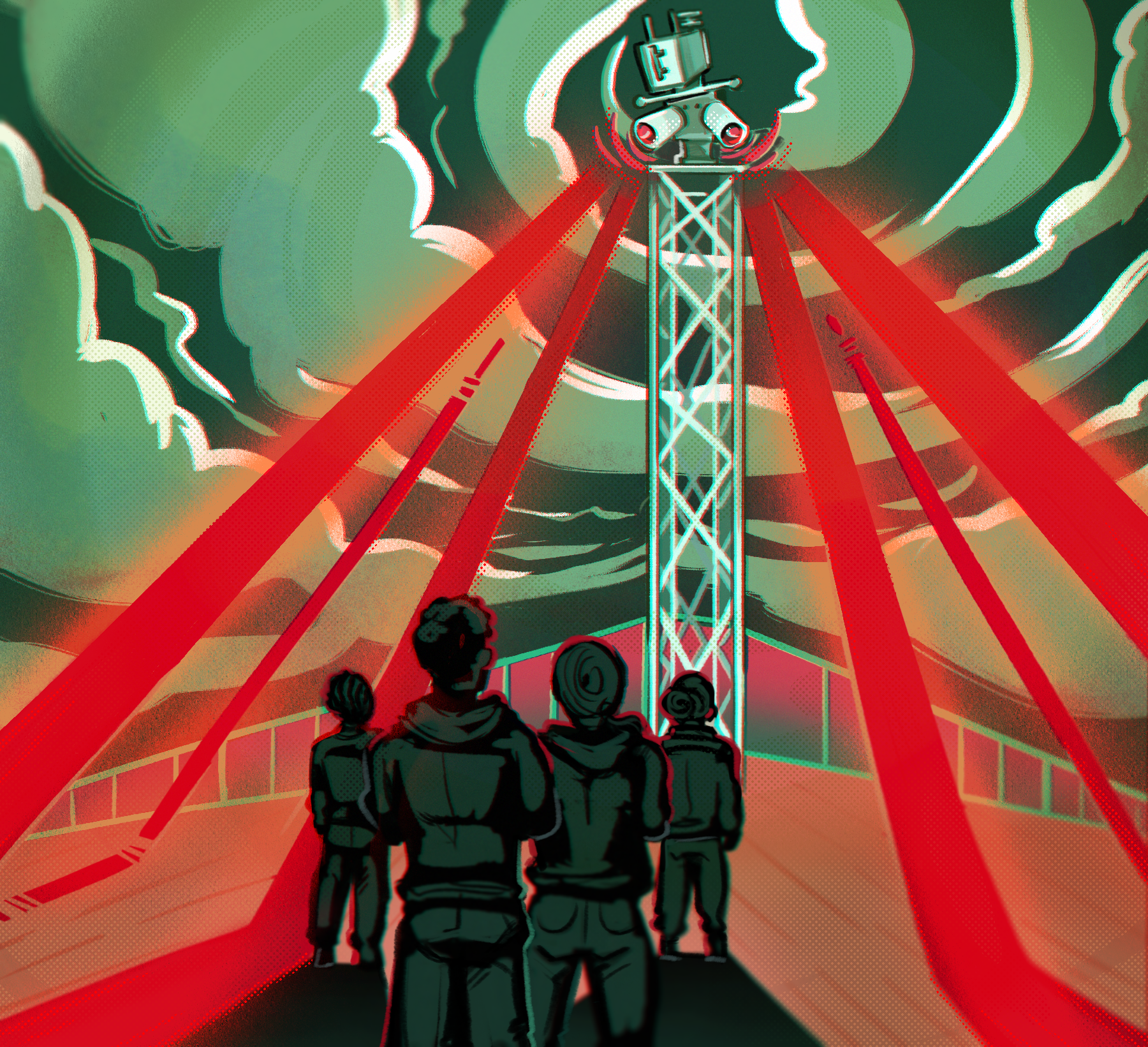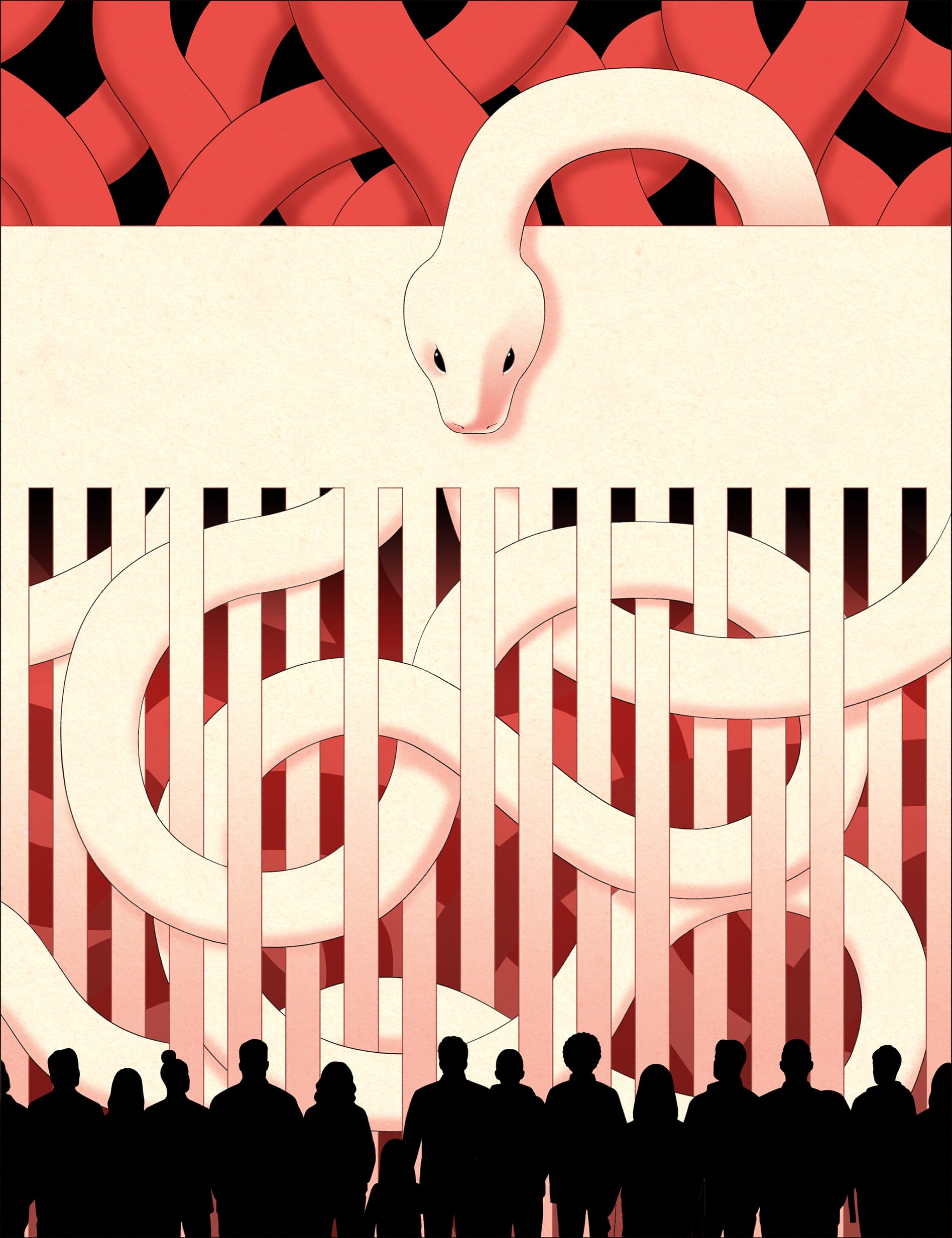Building solidarity to fight the everywhere border
Welcome to Surveillance Resistance Monthly, the Lab’s monthly newsletter that focuses on challenging the technologies that fuel state and corporate power. Alongside others, we seek to strengthen our collective analysis of these technologies of violence and control. We also aim to build, nurture and accumulate the power of organizing and resistance—locally and transnationally— against these technologies and the powers behind them.
Subscribe here, follow us on social media [on IG or X], or head to our website to learn more.
INTRODUCTION TO THIS ISSUE
This issue of Surveillance Resistance Monthly explores ‘The Everywhere Border’— an all-encompassing infrastructure that enables the police, other government agencies and their corporate partners to watch people wherever they are to facilitate arrest, containment, or exclusion. Through the deployment of information and surveillance technologies, the border traverses not only state boundaries, seas and oceans, but also reaches deeply into other countries, and cuts deep into the interior of the nation-state. We can observe how the border is now embedded into everyday life and encoded on peoples’ bodies — through digital IDs, landlord tech, digital payments systems, social welfare surveillance, biometric surveillance in public spaces. The Everywhere Border is also ideological, undergirded by logics and narratives that asserts that certain categories of people are a perpetual threat to “national security” or “public safety” — based on nationality, ethnicity, religion, expressing dissent and other markers.
The Surveillance Resistance Lab is informed by decades of work fighting the ascendency of an expansive border policing regime, in particular the Department of Homeland Security’s’ interior police force, Immigration and Customs Enforcement [ICE]. In this issue we include a special feature — an interview with our Executive Director, Mizue Aizeki, where they reflect on the police-to-deportation pipeline and the logics that fueled it, ICE raids, the campaign to digitization the IDNYC, and how all of this led to the creation of the Lab — a space to fight the everywhere border with partners in US and globally.
The Lab develops research, strategy, campaigns, and networks around three main areas of work. The first is Public Infrastructure, Tech & Democracy, where we grow democratic governance interventions for workers and communities in a solution space that has been dominated by corporations and policing interests. The second is Digital Infrastructures of Migration Control, where we are building a transnational solidarity network to investigate and combat how border externalization is advanced through digital surveillance across the Americas [you can read our first major report here], in partnership iLIT and R3D. The third is Making the Invisible Visible: the Internet as an Infrastructure of Control, a collaboration with organizers and scholars pushing back against the exploitative business models and practices that underlie the internet infrastructure.
We hope you enjoy this issue! If you have feedback or resources to share, please do get in touch.
In solidarity,
The Surveillance Resistance Lab team

SPECIAL FEATURE: INTERVIEW WITH MIZUE AIZEKI
THE SURVEILLANCE RESISTANCE LAB — WHY WE EXIST
Mizue Aizeki is the Executive Director and founder of the Surveillance Resistance Lab. For nearly twenty years, Mizue has focused on ending the injustices at the intersections of the criminal and migration control systems—including criminalization, imprisonment, and exile. The interviewer Dhaksh Sooriya is a Senior Research Fellow at the Lab.
Dhaksh: Mizue, how would you describe the Surveillance Resistance Lab?
Mizue: The Lab emerges at a moment where we are all confronting a global economy driven by the development and deployment of technologies that fuel social control, repression, and corporate power—and these are justified by logics and narratives that construct “threats” that must be policed and contained (for example, people on the move, BLM activists, students protesting for Palestine, workers organizing for their rights, indigenous people fighting to preserve water rights–the list goes on and on). To address this challenge, we do investigative research to strengthen our collective analysis of these technologies of violence and control. We also work alongside others to build, nurture and accumulate the power of organizing and resistance—locally and transnationally— against these technologies and the powers behind them.
Dhaksh: You often talk about how the Lab has to center an analysis that challenges how “security” is defined. Why is that?
Mizue: Fundamentally we have to grapple with how tech is being developed and used in ways that are accelerating an unequal balance of power, locally and globally—and how the “solutions” are all too often driven by cops and corporations. And in order to do that, we have to sharpen our analysis through which we understand how their power is reinforced materially and discursively. To counter the current regimes that control us, we need to have a theory and strategy about how we build power and who we build it with. Our work at the Lab is very much focused on the ascendancy of this paradigm of securitization, which is rooted in histories of settler colonialism, but that have shifted and adapted after 9/11 and since the founding of DHS. Securitization has become so normalized that we don't even see it. The Lab works to make this visible, so we can more effectively challenge it.
Dhaksh: In your book Resisting Borders and Technologies of Violence, your essay, titled Multiplying State Violence in the Name of Homeland Security, you talk about how organizing in the migrant justice movement for decades has shaped your work. How did those experiences lead you to start the Lab?
Mizue: I started to organize for migrant justice at a time when the attacks on the rights of immigrants in the US were accelerating. This was around 1993, when the LAPD were violently attacking undocumented workers organizing for union rights. Then, in 1996, the US government implemented extremely harsh immigration laws passed in 1996 that merged the War on Crime with a war on immigrants both rhetorically and materially–effectively made domestic policing a pipeline for deportation.
After the founding of DHS in 2002, when the government started to aggressively target people in the interior for detention and deportation, I started to organize with people who were being targeted by ICE for deportation due to having a criminal conviction. Many of these were long-time residents who had decades-old convictions who were just living their lives and then deemed all of a sudden to be “threats to public safety”—just because they were not citizens. Our main work in the 2010s was fighting the expansion of the police-to-deportation pipelines—campaigns against the automatic sharing of fingerprints between police and DHS and then for detainer policies to limit police collaboration with ICE. We also focused on the raids conducted by ICE police at homes, workplaces, and in communities. I remember clearly how the Obama administration constructed people with criminal convictions as perpetual threats during their mass raids. In our FOIAs, we saw how agents were told to find the most egregious cases and construct these people as ‘threats to public safety’. In my trajectory of work on migration control, I saw two things:
- The massive expansion of mass surveillance and the border industry in real time, including police and ICE information sharing, and biometrics etc.
- The growing justification for this huge investment in policing migrants in the interior, by linking it with criminalization.
So that is why I’m always thinking about how the material conditions are changing, and also what is the ideological and narrative work happening to justify these changes? It’s important to look at both ‘the material’ and ‘the discursive’ (i.e. the ideology/narratives).
‘The discursive’ aspect was clear in how the political momentum of the War on Terror normalized xenophobia and securitization, constructing an ever widening range of people as ‘threats to national security’, justifying widespread policing and control of migration. ‘The material’, on the other hand, was demonstrated by the growth of the physical infrastructure and technologies into what has become one of the world’s largest detention, deportation, and border exclusion systems.
Dhaksh: And what got you interested in technology and surveillance specifically?
Mizue: The thing that really struck me was the idea of ‘legibility’ and ‘visibility’ being really important to ICE. This is a key part of what surveillance and technology enable.
There was a moment in 2014 where a coalition of advocates became concerned with securing adequate privacy protections with the digitization of the IDNYC, particularly for undocumented people, unhoused people and gender non conforming people. Many of us were worried that it would be transformed into a form of surveillance. The resistance from the administration in hearing our concerns got me started on this journey of learning more about digital IDs systems. I started talking to people and doing research…and I was kind of blown away by what I found. The links with colonialism, and this broader ‘smart cities’ framework that was being used to promote the uptake of digital IDs around the world by states and their corporate partners. This made me deeply concerned about how surveillance fuels state violence and corporate power.
Dhaksh: So what was the outcome of the organizing around the digitization of the IDNYC?
Mizue: The NYPD wanted to retain the underlying documents of the digital ID, including birth certificates, passports etc for 5 years. We were able to fight for 2 years using the argument that there could be a new president in 2016, and it was unclear what their orientation would be. So once Trump was elected, these Republicans sued the city to turn over all those underlying documents.
Dhaksh: Wow, that example really demonstrates the long legacy of these kinds of data collection initiatives.
Mizue: Exactly. It’s like how the US government piloted its ‘identity dominance’ strategy during their invasion of Afghanistan, through cataloging the identity of anyone they believe could be a threat to “national security” through massive data collection - biometrics, family relationships, schooling, home and work addresses, and more. US captured identity documents and databases storing personally identifiable data then ended up in the hands of the Taliban.
After observing how data was collected in Afghanistan, in refugee camps, at borders, and through smart cities initiatives, in order to make individuals more legible for the purposes of control, one of the central ideas that animates that the Lab is challenging social control strategies such as identity dominance. The Surveillance Resistance Lab seeks to be a place where we can deepen our knowledge of these issues, build meaningful solidarity across borders, and work alongside others to engage in the global dimensions of this fight.
Dhaksh: And finally, how did all of your organizing experience and your watching the construction of this surveillance apparatus lead to the different focus areas of work at the Lab?
Mizue: Over the first two decades of this century, we have witnessed an unprecedented growth of state and corporate tools and practices that facilitate widespread tracking and targeting, suppression of dissent and organizing, and an overall erosion of rights. Following on the heels of decades of neoliberal and carceral policies, the ascendancy of tech-fueled governance and the “national security” surveillance economy threaten to deepen structural inequality as well as further undermine democracy—in schools, workplaces, in municipal governments, in public spaces. Our fight is local, national, and global. In order to fight it, we must make this vast infrastructure of control visible—because the powerful interests that rely on it are invested in keeping it obscured. This means building across often siloed sectors, across movements, and across borders. In this way, the Lab aims to expand the terrain upon which we organize to combat securitization and abolish the Everywhere Border.
For more on this topic you can read Mizue's essay titled 'Multiplying State Violence in the Name of Homeland Security' [Chapter 2 of Resisting Borders and Technologies of Violence].
WHAT’S ON AT THE LAB?
RECENT ACTIVITIES & UPCOMING EVENTS
Explainer on Digital and Tech-enabled Borders — The border regimes of imperialist states have brutally oppressed migrants throughout the world. To enforce their borders, these states have constructed a digital fortress with far-reaching and ever-evolving new technologies. In the name of “smart” borders, the U.S. and Europe have turned to private companies to develop a neocolonial laboratory now deployed against the Global South, borderlands, and routes of migration. They have established databases, digital IDs, electronic tracking systems, and facial recognition software to more “efficiently” categorize and control human beings and their movement.
As part of a newly launched web series by the University of Oxford Key Concepts and Ideas in Border Criminology, the Surveillance Resistance Lab’s Dhaksh Sooriya, provides a simple explainer on key concepts and emerging ideas in the field. They define the ‘digital borders’, as well as other crucial concepts such as: ‘border internalization’ [i.e. this refers to the ubiquity of digital surveillance in every facet of life that reinforces borders within a nation state; such as digital ID systems] and ‘border externalization’ [i.e. the expansion of borders outside of the nation state through the use of digital surveillance technologies such as cameras, drones and GIS-based risk analysis into surrounding lands and waters]. Also included is a Surveillance Studies reading list.
New York Book Launch of Resisting Borders and Technologies of Violence [Edited by Mizue Aizeki, Matt Mahmoudi and Coline Schupfer] — This month the Peoples’ Forum hosted the New York launch of this anthology. This book brings together in depth analyses on how high tech border imperialism is increasing racialized surveillance, control, and violence at borders and in cities, as well as case studies of how organizers and advocates are fighting back. The talk was hosted by Mizue Aizeki and involved contributors to the anthology including Miriam Ticktin, Fahd Ahmed, and Arun Kundnani. You can watch the recording here, and order a copy of the book here.
Coming Soon: New zine about the Department of Homeland Security — Refer to this post by artist Anuj Shrestha for a teaser of the stunning illustrations. The zine is written by scholar Arun Kundnani and Mizue Aizeki, founder of the Surveillance Resistance Lab.

Virtual space for organizers resisting surveillance tools — Dozens of states are quietly but quickly adopting Mobile Drivers Licenses (mDLs) programs, a Department of Homeland Security facilitated identification infrastructure which holds the potential to exacerbate the surveillance all of people especially those seeking abortions, those subject to racially discriminatory and gender-based policing, immigrants, and others. The Lab is hosting a monthly virtual space for local organizers and community members interested in building local campaigns resisting the adoption of these surveillance tools. In January, the Lab hosted a webinar on mobile driver's licenses with the National Immigration Law Center and in March, presented to the National Association of Criminal Defense Lawyer’s Public Defender Tech Training program. If you are interested in joining the monthly organizing space, please contact Ed at ed[at]surveillanceresistancelab.org.
EVENTS BY OUR PARTNER ORGANIZATIONS
Mijente and Media Justice’s Take Back Tech Conference — From June 21-23 organizers, advocates, academics and workers are gathering in Chicago to deepen connections, sharpen our analysis, develop strategies and build our collective power to Take Back Tech from the tech giants destroying our planet and devastating our communities. Ed Vogel and Dhaksh Sooriya from the Surveillance Resistance Lab will be presenting a workshop on the topic Organizing against the global expansion of digital IDs and automated policing. Dhaksh will also speak on a panel on day 2 called Here, There, and Everywhere: Global perspectives on the impact of tech. Mizue will then open Sunday’s book fair in a conversation with Ruha Benjamin and Jacinta Gonzalez. Register here.
RECOMMENDED READING / LISTENING / VIEWING ON TECH-ENABLED BORDERS
High-tech border imperialism is quietly remaking our world, scaling up colonial efforts of times past to divide desirables from undesirables, rich from poor, expat from migrant, and citizen from undocumented. Below, you can find research and resources on surveillance infrastructure and digital borders, as well as insights from organizers, artists and scholars who are employing creative tools to fight back and imagine a world without borders.
- Just Resistance: Building Toward a Demilitarized and Decolonized Future — This 2021 event presented by the Immigrant Defense Project, the Center for Constitutional Rights and Haymarket Books was the final event of a 4-part series marking the 20th anniversary of 9/11. Moderated by Mizue Aizeki, this panel brought together, Lara Kiswani, Arun Kundnani, Timmy Châu and Fernando Martí to talk about our collective path forward including the abolition of borders and the complete defunding of the military industrial complex within a future of economic, racial, gender and climate justice.
- Digital Migration Control Infrastructure as Worldmaking — This law review journal article by Laura M Bingham, Santiago Narváez, Teresa Perosa and Mizue Aizeki, identifies and analyzes a typology of technologies used to control human movement and their "worldmaking" quality, i.e. ability to shape the reality at a planetary scale.
- Apartheid Tech: The Use and Expansion of Biometric Identification and Surveillance Technologies in the Occupied West Bank [book chapter] — In Chapter 26 of Resisting Borders and Technologies of Violence, Marwa Fatafta outlines the facial recognition systems and extensive biometrics surveillance databases deployed by Israel to automate its the enforcement of the apartheid system and population control of Palestinians.
- The Future of Border Patrol: AI Is Always Watching — This Markup piece looks at the ways in which US authorities are seeking to expand the use of AI in border surveillance. As outlined in the comment by Mizue Aizeki, this results in additional opaqueness for asylum seekers attempting to secure the limited rights they have.
